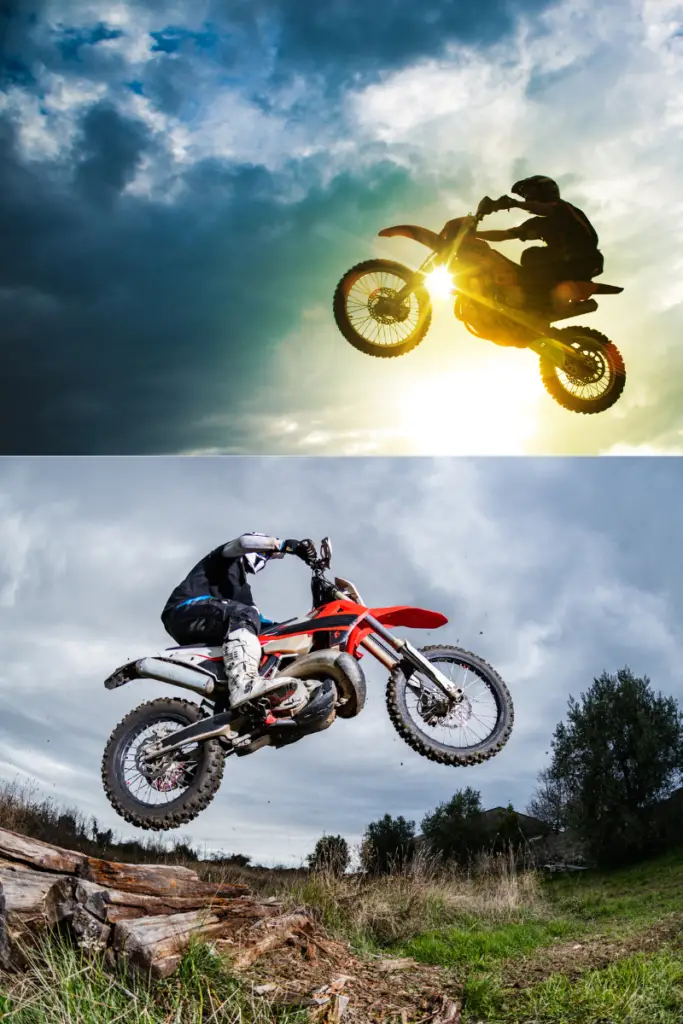
Motocross and enduro bikes are built for off-road riding but for different off-roading styles. Some significant differences set each bike apart but make them perfect for their intended purpose.
Enduro bikes are for long-distance off-road riding, including riding into the night. Their suspension is softer for a more comfortable ride and equipped with lights and large fuel tanks. Motocross bikes are made for track racing and are light, with hard suspensions, and have no lights.
The differences between a motocross bike and an enduro bike are substantial because they are designed for specific off-road riding styles. Are these differences enough that you cannot use an enduro bike for motocross and vice versa?
Is A Motocross Bike The Same As A Enduro Bike?

Off-road bike riding requires bikes designed for the terrain and the style of riding used in that terrain. So what does this mean when comparing the design and features of an enduro bike and a motocross bike?
Suspension Differences Between Motocross And Enduro Bikes
Motocross bikes are typically used on a specially designed, roughly circular track with large jumps, large ruts, corrugations, and sometimes lots of mud and water.
The suspension on a motocross bike is designed to be very hard to handle the extremely rough terrain and the large jumps to prevent damage to the bike. The hard suspension enables the rider to control the bike much easier on the rugged track.
Although the hard suspension on the motocross bike is suitable for the track, it is hard on the rider and creates jarring that tires the rider out, especially over long distances. Motocross races are typically between 45 minutes to an hour, making the hard suspension less of an issue for the rider.
Enduro bikes are made for long off-road cross-country races, such as rallies. The suspension on an enduro bike is softer to provide more comfort for the long ride. The softer suspension comes at a price, making the enduro bike less suitable for extremely rough terrain and large jumps.
Weight Differences Between Motocross And Enduro Bikes

Motocross bikes are designed to be thrown around a track with tight turns, requiring a lightweight bike to gain an advantage over competitors and to prevent the rider from becoming fatigued during the race.
This weight restriction makes motocross bikes minimalistic, and the machine does not include irrelevant equipment that would increase the bike’s weight.
Consequently, motocross bikes have smaller engines, lightweight frames, no headlights, no battery, and no electric starter motor.
In contrast, enduro bikes are made to carry additional weight, which requires a more robust frame, a stronger engine, and an electric starter motor to make starting the large engine easier.
The cross-country nature of enduro riding means that riders often pack supplies, parts, camping gear, and other equipment on the bike. The additional packing space required in the form of panniers and racks adds to the weight of the enduro bike.
The heavier enduro bike is unsuitable for fast, tight turns around a track and the large jumps normally associated with motocross riding.
Fuel Tank Differences Between Motocross and Enduro Bikes
Motocross bikes are usually fitted with low-capacity fuel tanks to only hold enough fuel for about an hour of riding time.
The smaller fuel tank on motocross bikes reduces weight and gives the rider more space to use a forward riding position on the bike for certain parts of the track.
Enduro bikes are fitted with larger tanks to cater to longer riding times and distances on a single tank of fuel. Enduro bike races may require the rider to ride an entire day and into the late hours of the night, requiring a greater fuel tank capacity than an hour riding on a track.
The larger tank limits the rider’s position to sitting further back on the seat, and the additional fuel load contributes to the heavier weight of the enduro bike.
The larger fuel tank on the enduro bike is an advantage for long hours of cross-country riding but is cumbersome and ungainly around a tight motocross track.
Electric Differences Between Motocross And Enduro Bikes

The cut-down minimalistic nature of motocross bikes makes electrical systems mostly redundant and unnecessary on these bikes.
Motocross bikes generally do not have headlights, tail lights, turn indicators, or starter motors. The lack of electric components means that the bike does not need to carry a battery to power the electrical components, adding to the lightweight nature of these bikes.
The lack of electric components makes motocross bikes not street-legal, and they can only be used off-road or on the motocross track.
Enduro bikes are equipped with electric components more typical of street legal bikes, including head and tail lights and turn signals. Enduro bikes are sometimes used on rural gravel roads, which requires them to be street legal. Enduro races often finish the day’s racing after dark, making lights a requirement on these bikes.
The larger motors on enduro bikes are difficult to start with a kick-start mechanism, making an electric starter motor a convenience often included in an enduro bike.
Can You Use A Motocross Bike As An Enduro Bike?
The design features of the enduro and motocross bikes make them perfect for the riding they are designed. Is there any crossover where you can use a motocross bike for enduro racing and vice versa?
Motocross bikes can be used off-road in any terrain, but the small fuel tank and the hard suspension are the biggest limitations. The small fuel tank will limit the ride time on the motocross bike, and the hard suspension will cause rapid rider fatigue when riding this bike over a long distance.
Enduro bikes are not suitable for riding on a motocross track because they are large, heavy, and cumbersome. The suspension is too soft, making the bike difficult to control on the tough track, and may even cause damage to the bike on large jumps or extensive corrugations.
Conclusion
Motocross and enduro bikes are designed for different purposes, with the design features making each bike suitable for the intended type of riding.
Enduro bikes are not suited to motocross track riding, and motocross bikes are not suitable for enduro off-road riding. Choose the bike designed for the type of off-road riding you do the most.
If you ride enduro and motocross, you will need two bikes; one for each discipline. This is not a hardship for bike lovers since you can never have too many bikes!
References
https://singletrackworld.com/forum/topic/whats-the-difference-between-an-mx-bike-and-an-enduro-bike/
https://thedirtbiker.com/enduro-vs-motocross-which-one-is-better/https://www.dirtbikeplanet.com/enduro-vs-trail-dirt-bikes-21-pros-and-cons/


